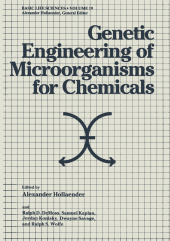 Neuerscheinungen 2012Stand: 2020-01-07 |
Schnellsuche
ISBN/Stichwort/Autor
|
Herderstraße 10
10625 Berlin
Tel.: 030 315 714 16
Fax 030 315 714 14
info@buchspektrum.de |

Alexander Hollaender
Genetic Engineering of Microorganisms for Chemicals
Herausgegeben von Hollaender, Alexander
Softcover reprint of the original 1st ed. 1982. 2012. xiii, 486 S. 45 SW-Abb. 254 mm
Verlag/Jahr: SPRINGER, BERLIN 2012
ISBN: 1-468-44144-2 (1468441442)
Neue ISBN: 978-1-468-44144-4 (9781468441444)
Preis und Lieferzeit: Bitte klicken
The normal course of most biologically catalyzed processes is tightly regulated at the genetic and physiological levels. The regulatory mechanisms are diverse, sometimes redundant, and it is becoming increasingly apparent that, at the genetic level, the range of mechanisms may be limited only by the permutations and combina tions available. For each microbial cell, evolution appears to have resulted in maximized advantage to that cell, achieving regulatory balance. Genetic engineering encompasses our attempts to perturb the genetic regulation of a cell so that we may obtain desired other than normal outcomes, such as increased product formation, or new product formation. Following the groundwork established by a preceding symposium (Trends in the Biology of Fermentations for Fuels and Chemicals, Brookhaven National Laboratory, December 1980), the initial planning for this conference envisioned the juxtaposition of molecular genetic expertise and microbial biochemical expertise. The resultant interaction should encourage new and extended ideas for the improve ment of strains and for the generation of new regulatory combina tions to enhance microbial chemical production from cheap and abundant (including waste) substrates. The interaction should also demonstrate that new discoveries at the basic level remain essential to progress in genetic engineering. New genetic regulatory combina tions require new studies of physiology and biochemistry to assure understanding and control of the system. New biochemical reactions necessitate new studies of genetic and regulatory interaction.
Welcoming Remarks.- Plasmids as Vectors for Gene Cloning: Past, Present, and Future Use.- Strategies: Techniques and Molecular Systems (Chairmanīs Introduction).- Cloning Vectors Derived from Bacterial Plasmids.- Expression of a Foreign Procaryotic Gene in Bacillus subtilis.- Fusion of Microbial Protoplasts: Problems and Perspectives.- Strategies: Models and Problems, (Chairmanīs Comments).- Bakerīs Yeast: A Successful Industrial Microorganism Is Now a Favorable Host for Molecular Cloning.- Transformation of Neurospora crassa Utilizing Recombinant Plasmid DNA.- Perspectives for the Genetic Engineering of Hydrocarbon Oxidizing Bacteria.- Photosynthesis and Cloning in Cyanobacteria.- Models for Genetic Manipulation of Actinomycetes.- The Regulation of Yeast Gene Expression by Multiple Control Elements.- Strategies for Cloning in Bacillus subtilis.- Genetic and Molecular Studies of the Regulation of Atypical Citrate Utilization and Variable Vi Antigen Expression in Enteric Bacteria.- Molecular Cloning in the Streptococci.- Genetic Engineering of Microorganisms for Chemicals: Diversity of Genetic and Biochemical Traits of Pseudomonads.- Beginning Genetics with Methanogens.- Chlorophyll-Binding Proteins: Strategies and Developments for DNA Cloning in Rhodopseudomonas sphaeroides.- Acinetobacter: A Tale of Two Genera.- Genetic Alteration of Zymomonas mobilis for Ethanol Production.- Structure and Expression of Yeast Glycolytic Genes.- Functional Mutants of Yeast Alcohol Dehydrogenase.- Towards the Development of Marketable Products (Chairmanīs Comments).- The Alcohol Dehydrogenase Genes of the Yeast, Saccharomyces cerevisiae: Isolation, Structure, and Regulation.- Genetic Deregulation of Ethanol-Related Genes.- Lactate Dehydrogenase-Deficient Mutants of Streptococcus mutans.- Generation of Products by Methanotrophs.- The Role of Nickel in Methanogenic Bacteria.- Mother Nature Likes Some Halogenated Compounds.- Genetics and Biochemistry of Tylosin Production: A Model for Genetic Engineering in Antibiotic-Producing Streptomyces.- Roundtable Discussion of Research Priorities.- List of Speakers.- List of Participants.- Species Index.


